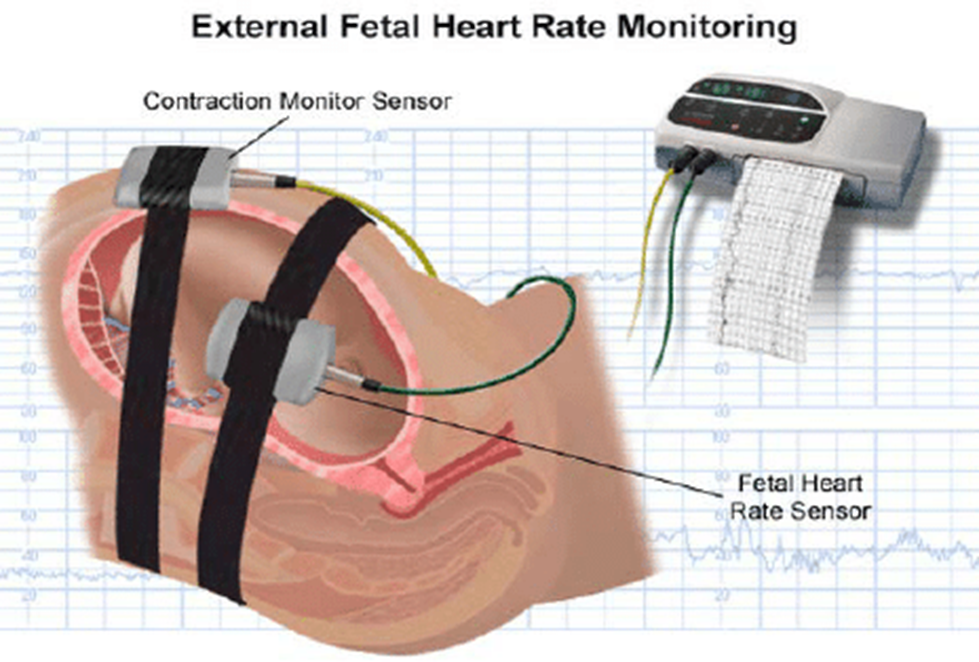A nurse is teaching a client who is scheduled for a non-stress test. Which of the following information should the nurse include? Choice Options:
An IV will be initiated prior to the test.
The client will be asked to stimulate her nipples for 5 minutes during the test.
The client will receive an ultrasound prior to the test.
An external fetal monitor will be used to monitor the fetus.
The Correct Answer is D
Rationale for Choice A:
An IV is not routinely initiated prior to a non-stress test. It may be started if a biophysical profile (BPP), which includes an ultrasound, is also being performed, or if there is a risk of complications that may necessitate immediate intervention. However, it is not a standard part of the non-stress test itself.
Rationale for Choice B:
Nipple stimulation is not a standard component of a non-stress test. It may be used in some cases to try to induce fetal movement if the fetus is not moving actively enough during the test. However, it is not a routine part of the procedure.
Rationale for Choice C:
An ultrasound is not typically performed prior to a non-stress test. It may be done as part of a BPP, but it is not necessary for the non-stress test itself.
Rationale for Choice D:
An external fetal monitor is essential for conducting a non-stress test. This monitor uses two belts that are placed around the mother's abdomen. One belt measures the fetal heart rate, and the other belt measures uterine contractions. The monitor records the fetal heart rate and any contractions for a period of 20 to 40 minutes. The test is considered reactive (normal) if the fetal heart rate increases by at least 15 beats per minute for at least 15 seconds twice during the test. This acceleration in heart rate is typically in response to fetal movement.

Nursing Test Bank
Naxlex Comprehensive Predictor Exams
Related Questions
Correct Answer is D
Explanation
Rationale for Choice A:
A pelvic exam is required if you want birth control pills. This response is not therapeutic because it dismisses the client's feelings and does not address her concerns. It focuses on the policy or requirement rather than the client's emotional needs. It could make the client feel like her anxiety is not justified or that she has no choice in the matter.
Rationale for Choice B:
Don't worry, I will stay in there with you for the exam. While this response may be intended to provide reassurance, it does not fully address the client's underlying concerns. It offers a solution without first exploring the specific reasons for the client's anxiety. It could also make the client feel dependent on the nurse's presence for comfort, rather than empowering her to manage her own anxiety.
Rationale for Choice C:
All you need to do is relax during the exam. This response is not therapeutic because it minimizes the client's feelings and suggests that she can simply control her anxiety by relaxing. It does not acknowledge the validity of her concerns or provide any guidance on how to manage those concerns. It could make the client feel like her anxiety is her fault or that she is not coping well.
Rationale for Choice D:
Tell me more about your concerns. This is the most therapeutic response because it encourages the client to express her feelings and concerns openly. It validates the client's experience and demonstrates active listening and empathy. It provides an opportunity for the nurse to gather more information about the specific reasons for the client's anxiety and to tailor interventions accordingly. It also empowers the client by allowing her to share her thoughts and take control of the conversation.
Correct Answer is A
Explanation
Choice A rationale:
Maternal smoking is a major risk factor for low birth weight. Studies have consistently shown that infants born to mothers who smoke during pregnancy are more likely to be born prematurely and have a lower birth weight compared to infants born to non-smoking mothers.
Nicotine, a primary component in cigarettes, is a vasoconstrictor that reduces blood flow to the placenta. This decreased blood flow can deprive the developing fetus of oxygen and essential nutrients, leading to impaired growth and development.
Carbon monoxide, another harmful substance in cigarette smoke, binds to hemoglobin in the blood, reducing its ability to carry oxygen. This can also contribute to fetal hypoxia and growth restriction.
Smoking can also interfere with placental function, further compromising the delivery of nutrients and oxygen to the fetus.
Choice B rationale:
While some studies have suggested a possible link between maternal smoking and hyperactivity in children, the evidence is not conclusive. Further research is needed to establish a definitive association.
Choice C rationale:
There is no clear evidence to suggest that maternal smoking directly causes hypersensitivity to noise in newborns.
Choice D rationale:
Craniofacial abnormalities are not typically associated with maternal smoking. They are more commonly caused by genetic factors or exposure to certain medications or substances during pregnancy.
Whether you are a student looking to ace your exams or a practicing nurse seeking to enhance your expertise , our nursing education contents will empower you with the confidence and competence to make a difference in the lives of patients and become a respected leader in the healthcare field.
Visit Naxlex, invest in your future and unlock endless possibilities with our unparalleled nursing education contents today
Report Wrong Answer on the Current Question
Do you disagree with the answer? If yes, what is your expected answer? Explain.
Kindly be descriptive with the issue you are facing.
